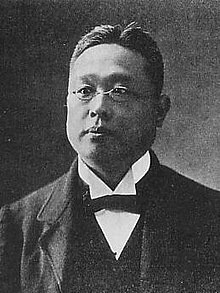Yamagata Isaburō
Yamagata Isaburō | |
|---|---|
山縣 伊三郎 | |
 Prince Yamagata Isaburō | |
| Born | Katsu Isaburō 6 February 1858 |
| Died | 24 September 1927 (aged 69) |
| Nationality | |
| Occupation(s) | Politician, cabinet minister |
| Spouse | Katō Takako |
| Children | Yamagata Arimichi (son) Yamagata Saburo (son) |
| Parents |
|
| Relatives |
|
| Family | Tsurumi Moriyoshi (brother) |
Prince Yamagata Isaburō (山縣 伊三郎, born Katsu Isaburō; 6 February 1858 – 24 September 1927) was a Japanese politician, cabinet minister, and Japanese Inspector-General of Korea. His wife was the daughter of Katō Hiroyuki.
Biography
[edit]Katsu Isaburō was born in Nagato Province in Chōshū Domain (present-day Yamaguchi prefecture, as the second son of samurai Katsu Kanesuke and Yamagata Toshiko, the elder sister of Yamagata Aritomo. As the latter had no children, he was adopted by Yamagata Aritomo in 1861 to carry on the family name.
After the Meiji Restoration, accompanied the Iwakura Mission to the United States and Europe, remaining in Germany for studies. On his return to Japan, he worked as a translator at the Foreign Ministry, and subsequently served on the Cabinet Legislation Bureau. He then entered the Home Ministry as served as Secretary to the governor of Aichi Prefecture before being appointed governor of Tokushima Prefecture, followed by Mie Prefecture. He was later promoted to Director of the Local Affairs Bureau within the Home Ministry, and rose to the post of Vice Minister.
In 1906, Yamagata entered the 1st Saionji administration as Minister of Communications. His chief achievement was to bring about the collapse of the Saionji administration by creating a budgetary deadlock over railroad funding at the behest of Yamagata Aritomo.[1]
In July 1908, Yamagata was appointed to a seat in the House of Peers in the Diet of Japan. In 1910, following the resignation of Itō Hirobumi as Resident-General of Korea, Yamagata accompanied the new Resident Sone Arasuke to Korea as Deputy Resident-General. Following the formal annexation of Korea to the Empire of Japan, Yamagata remained for the next nine years as Inspector-General of Korea, (a position equivalent to that of Deputy Governor-General), under the tenure of Governor-General Terauchi Masatake and Hasegawa Yoshimichi. Although considered to be the leading candidate to replace Hasegawa, Yamagata was removed from office during the government reorganization following the March 1 Movement in 1919.[2] He subsequently served as Governor-General of Kwantung Leased Territory from May 1920 to September 1922.
In February 1922, after the death of his foster-father Yamagata Aritomo, he inherited the kazoku title of kōshaku (prince). In January 1925, he sent to French Indochina as head of a special mission. Yamagata served on the Privy Council until his death in 1927.
Honours
[edit]From the Japanese Wikipedia article
Decorations
[edit]- Order of the Sacred Treasure, Third Class (27 December 1902; Fourth Class: 28 December 1898; Fifth Class: 26 June 1897; Sixth Class: 21 June 1895)
- Grand Cordon of the Order of the Rising Sun (21 July 1909; Second Class: 1 April 1906)
- Grand Cordon of the Order of the Rising Sun with Paulownia Flowers (24 September 1927; posthumous)
References
[edit]- ^ Notehelfer, F. G. (2011). Kotoku Shusui: Portrait of a Japanese Radical. Cambridge University Press. ISBN 978-0521131483. page 157
- ^ Caprio, Mark (2015). Japanese Assimilation Policies in Colonial Korea, 1910-1945. University of Washington Press. ISBN 978-0295990408. page 125
External links
[edit]- Government ministers of Japan
- 1858 births
- 1927 deaths
- Governors of Aichi Prefecture
- Governors of Tokushima Prefecture
- Japanese colonial governors and administrators
- Members of the House of Peers (Japan)
- Kazoku
- People of Meiji-era Japan
- People of the Kwantung Leased Territory
- Politicians from Yamaguchi Prefecture
- People from Chōshū Domain
- Recipients of the Order of the Plum Blossom
